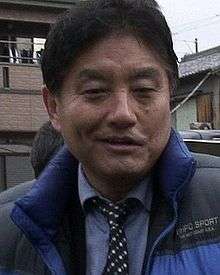Takashi Kawamura (politician)
| Takashi Kawamura | |
|---|---|
| 河村 たかし | |
 | |
| 21st Mayor of Nagoya | |
|
Assumed office 28 April 2009 | |
| Preceded by | Takehisa Matsubara |
| Member of the House of Representatives | |
|
In office 19 July 1993 – 7 April 2009 | |
| Succeeded by | Yūko Satō |
| Constituency |
Aichi-1st (2006–2009) Old Aichi-1st (1993–1996) |
| Personal details | |
| Born |
November 3, 1948 Nagoya, Aichi, Japan |
| Political party | Genzei Nippon |
| Other political affiliations | |
| Alma mater | Hitotsubashi University |
| Website | Official website |
Takashi Kawamura (河村 たかし Kawamura Takashi, born 3 November 1948) is a Japanese politician of the Nagoya-based Genzei Nippon (減税日本 "Tax Cut Japan") party and a former member of the House of Representatives in the Diet (national legislature). Kawamura is currently serving as Mayor of Nagoya.
Biography
A native of Nagoya, Aichi and graduate of Hitotsubashi University, he was elected for the first time in 1993 as a member of Morihiro Hosokawa's Japan New Party after an unsuccessful run in 1990. He resigned from his office of a member of House of Representatives, ran for mayor of Nagoya, and was elected in April 2009.
On February 6, 2011 he won a landslide re-election victory. Voters in Nagoya gave him three times the votes of his DPJ rival. Also nearly three-quarters of voters supported a referendum to dissolve the sitting Nagoya assembly, since the mayor clashed with the assembly repeatably on issues such as devolution and cutting down the generous diets and retirement packages of assembly members to save costs for taxpayers.[1]
The mayor announced plans in 2009 to completely reconstruct the main towers of Nagoya Castle that were destroyed during the Second World War in wood, just as in the original structure.[2][3][4]
Controversy
On 20 February 2012, while serving as the Japanese representative of Nagoya, Mayor Takashi Kawamura made denialist statements about the Nanjing Massacre while receiving an official Chinese delegation from Nanjing.[5] The incident led to the suspension of all official exchange between the two cities of Nagoya and Nanjing on 21 February.[6]
Some Nagoya citizens opposed Takashi Kawamura's denial by organising lectures and setting a website.[7]
References
- ↑ The Economist. Grass-roots revolt in Japan: Maverick as hell. Grass-roots revolt in Japan. February 10, 2011.
- ↑ http://www.nikkei.com/article/DGXLASFD24003_T21C14A0000000/
- ↑ http://www.nikkei.com/article/DGXNASDG0401J_W2A101C1CR0000/
- ↑ "Archived copy". Archived from the original on 2013-06-18. Retrieved 2013-06-18.
- ↑ Wang, Chuhan (22 February 2012). "Nanjing to suspend official exchanges with Nagoya". CNTV.
- ↑ Wang, Chuhan (22 February 2012). "Nanjing suspends official contact with Nagoya". CNTV.
- ↑ Joseph Essertier and Ono Masami, David vs. Goliath: Resisting the Denial of the Nanking Massacre, Japan Focus 2014/2/21.
- 政治家情報 〜河村 たかし〜. ザ・選挙 (in Japanese). JANJAN. Archived from the original on 2007-12-03. Retrieved 2007-10-20. External link in
|work=(help)
External links
- Official website in Japanese.
- Genzei Nippon Party official website
| Political offices | ||
|---|---|---|
| Preceded by Takehisa Matsubara |
Mayor of Nagoya 28 April 2009 – present |
Succeeded by Incumbent |